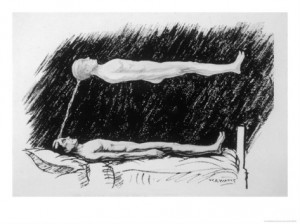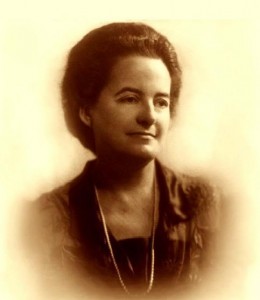Menopausal Mystics in Space
In my “Psychic Astronauts” post several months ago I thought I was being somewhat original by imagining a hypothetical cost-efficient scenario for our future exploration and colonization of space—one that made use of the interesting (at-this-point-unproven, admittedly highly controversial) notion of nonlocal mind. Specifically, I suggested that highly trained psychic explorers could remote view distant planets, visit them astrally (or, to be pedantically precise, etherically), telepathically manipulate organisms there across vast epochs of their evolutionary history (remembering that nonlocality applies to time as well as space), and then psychically inhabit or “possess” specially bred remote host vessels.
 Faxing ourselves across space and time in this fashion sounds convoluted and crazy … but basically, if there is any truth to the claims of psychic researchers, remote viewers, and mystics since time immemorial, then there’s really nothing (other than our own present lack of development of those capacities) that would inherently prevent such a possibility. A project to train hundreds or thousands of psychic astronauts would be far less costly (and time consuming) than even a mere manned Mars mission, let alone a Star Trek-style space program.
Faxing ourselves across space and time in this fashion sounds convoluted and crazy … but basically, if there is any truth to the claims of psychic researchers, remote viewers, and mystics since time immemorial, then there’s really nothing (other than our own present lack of development of those capacities) that would inherently prevent such a possibility. A project to train hundreds or thousands of psychic astronauts would be far less costly (and time consuming) than even a mere manned Mars mission, let alone a Star Trek-style space program.
I was certainly aware that this plan mashes together various ideas that have all appeared in science fiction—especially from the more open-minded, less slavishly scientistic era of pulp. H.P. Lovecraft, with his telepathic slumbering Old Ones, springs immediately to mind. (More recent scenarios of prehistoric alien visitation/intervention—such as those of Erich von Daniken, Zechariah Sitchin, and lately Ridley Scott—are more mundanely nuts-and-bolts, using actual spaceships, etc., in keeping with the dogmatic materialism of our day.) Until today, though, I had no idea of the true pedigree of the concept of psychic astronautics.
In a landmark archaeology of what could be called ‘ancient psychic astronaut theory’ on his blog The Secret Sun, Christopher Loring Knowles reveals that the Theosophical writings of Alice Bailey, especially her 1922 book Initiation: Human and Solar—supposedly channeling a Tibetan Ascended Master named “Djwal Khul”—describe precisely the scenario I sketched, albeit in reverse: the psychic colonization of Earth (via astral travel) by beings from the Sirius star system, who shaped ape-men into human beings to serve as receptacles for their consciousness.
Knowles is less interested in the crazy scenario than in its literary borrowing (too weak a word) by Lovecraft himself. In a point-by-point comparison, he shows that the parallels between Lovecraft’s “Call of Cthulhu” and Bailey’s channeled revelations about Earth’s distant past are so close as to be essentially plagiarism. Knowles suggests that the Darwinian Lovecraft originally wrote his dark novella in 1926 as a parody of the Theosophist’s occult ideas, but that he then carefully omitted all mention of Bailey’s book to his friends, not wanting to betray the unoriginality of his basic (and, in his hands, pretty damn cool) cosmic premise.
Though it doesn’t really dim my appreciation for Lovecraft, I love Knowles’ discovery. He notes that Theosophy, with its violet-hued astral planes and Ascended Masters in flowing gowns, was written mainly for an older, female audience. Terence McKenna (for whom the real ancient astronauts were the Stropharia cubensis mushroom) derisively referred to this demographic as “menopausal mystics.” Although there is a lot that is unoriginal, deeply questionable, and by modern standards rather un-awe-inspiring in the Theosophists’ cosmological visions, there is also much of value in their writings—particularly if you are open minded to the idea of siddhis, psychic abilities, and human potential in general. And they certainly supplied plenty of cool and original ideas to a generation of sci-fi writers who were less fetishizing of technology and more open-minded about the future (and past) of consciousness than many present-day writers.
Wouldn’t it be strange, and sort of wonderful, if mankind’s real future in space turned out to more closely resemble the channeled revelations of an early 20th Century menopausal mystic than the promethean hi-tech visions of Arthur C. Clarke and Stanley Kubrick, or Ridley Scott?





